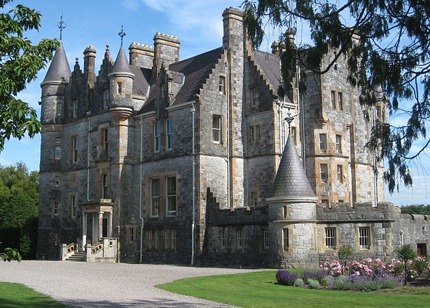Blarney Castle, as viewed by the visitor today, is the third to have been erected on the site. The first building in the tenth century was a wooden structure.
Blarney Stone
Blarney Castle Legends
Poison Gardens Blarney Castle
Attractions in Ireland
Around 1210 A.D. this was replaced by a stone structure which had the entrance some twenty feet above the ground on the north face. This building was demolished for foundations. In 1446 the third castle was built by Dermot McCarthy, King of Munster of which the keep still remains standing.

Cormac McCarthy, King of Munster
The lower walls are fifteen feet, built with an angled tower by the McCarthys of Muskerry. It was subsequently occupied at one time by Cormac McCarthy, King of Munster, who is said to have supplied four thousand men from Munster to supplement the forces of Robert the Bruce at the battle of Bannockburn in 1314. Legend has it that the latter king gave half of the Stone of Scone to McCarthy in gratitude. This, now known as the Blarney Stone, was incorporated in the battlements where it can now be kissed.
Queen Elizabeth wanted Blarney Castle
The Earl of Leicester was commanded by Queen Elizabeth I to take possession of the castle. Whenever he endeavoured to negotiate the matter, McCarthy always suggested a banquet or some other form of delay. So when the queen asked for progress reports a long missive was sent, at the end of which the castle remained untaken. The queen was said to be so irritated that she remarked that the Earl’s reports were all ‘Blarney’.
Lord Broghill finally broke the walls
The castle was eventually taken by Cromwell’s General, Lord Broghill. He succeeded in breaking the tower walls by planting a gun on Card Hill opposite the castle and above the lake below.
However, when his men entered the keep, he found two old retainers. The main garrison had fled by the underground caves situated below the battlements known as the Badgers Caves. There are three passages, one to Cork, one to the lake and one seemingly to Kerry. At any rate all had gone, along with the reputed gold plate.
Sold to Sir James St. John Jefferyes in 1688
A subsequent owner of the estate endeavoured to drain the lake, at the bottom of which the plate was supposed to have been thrown. A fortune was spent in vain. The estate was forfeited by Donogh McCarthy, 4th Earl of Clancarthy, who supported James II in the Williamite Wars. The property passed to the Hollow Sword Blade Company who subsequently sold it to Sir James St. John Jefferyes, Governor of Cork in 1688.
Building of Blarney House
His son, by same the name, was Minister Plenipotentiary for England at the court of Charles’ Battle of Poltava.
He was rewarded with a full length portrait of the king and a ruby gilted sword, which he subsequently sold to improve the land surrounding the castle.

At the beginning of the eighteenth century during the reign of Queen Anne, Sir James St. John Jefferyes built a Georgian gothic house up against the keep of the castle as was then the custom all over Ireland.
At the same time the Jefferyes’ family laid out a landscape garden known as the Rock Close with a remarkable collection of massive boulders and rocks arranged around what seemed to have been druid remains from pre-historic times. Certainly, many of the yew trees and evergreen oaks are extremely ancient.
In 1820 the house was accidentally destroyed by fire and the wings now form a picturesque adjunct to the keep.
The Jefferyes intermarried on 14th January 1846 with the Colthurst family of Ardrum, Inniscarra and Ballyvourney, Co. Cork, and Lucan, Co. Dublin. Lady Colthurst decided to build the new castle in Scottish baronial style south of the present keep. This was completed in 1874 and has been the family home ever since.